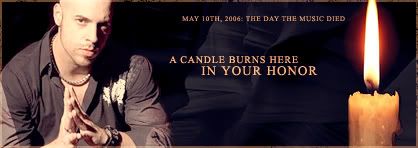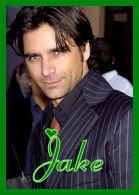|
|
Post by Monica on Nov 25, 2005 13:15:43 GMT -5
On my own message board I post celebrities who have passed away. A man from my childhood shows and movies has passed away and I thought I would post these here as well. I use CNN and Morty's for my info.
|
|
|
|
Post by Monica on Dec 10, 2005 17:21:55 GMT -5
Comedian Richard Pryor dies at 65  Saturday, December 10, 2005 Posted: 2141 GMT (0541 HKT) Comedian Richard Pryor died at Encino Hospital in Southern California on Saturday. He was 65.(CNN) -- Groundbreaking Comedian Richard Pryor died Saturday of a heart attack, his wife told CNN. He was 65. Pryor, who had been ill with multiple sclerosis, died at Encino Hospital near Los Angeles, at 7:58 a.m. PT. Jennifer Lee Pryor tried to revive him before paramedics arrived and took him to the hospital, she said. "He enjoyed life right up until the end," she said. "At the end there was a smile on his face." Pryor, who was born in Peoria, Illinois, on December 1, 1940, was diagnosed with multiple sclerosis in 1986. "He was able to turn pain into comedy," his wife said. "He let the world see it, and that was his inspiration too. "People said, 'If he can do it, I can do it.' " |
|
|
|
Post by Monica on Jan 14, 2006 13:37:44 GMT -5
BEVERLY HILLS, California (AP) -- Shelley Winters, the forceful, outspoken star who graduated from blond bombshell parts to dramas, winning Academy Awards as supporting actress in "The Diary of Anne Frank" and "A Patch of Blue," has died. She was 85.
Winters died of heart failure early Saturday at The Rehabilitation Centre of Beverly Hills, her publicist Dale Olson said. She was hospitalized in October after suffering a heart attack.
The actress sustained her long career by repeatedly reinventing herself. Starting as a nightclub chorus girl, she advanced to supporting roles in New York plays, then became famous as a Hollywood sexpot.
A devotee of the Actors Studio, she switched to serious roles as she matured, and she won her Oscars portraying mothers. Still working well into her 70s, she had a recurring role as Roseanne's grandmother on the 1990s TV show "Roseanne."
In 1959's "The Diary of Anne Frank," she was Petronella Van Daan, mother of Peter Van Daan and one of eight real-life Jewish refugees in World War II Holland who hid for more than a year in cramped quarters until they were betrayed and sent to Nazi death camps. The socially conscious Winters donated her Oscar statuette to the Anne Frank House in Amsterdam.
In 1965's "Patch of Blue," she portrayed a hateful, foul-mouthed mother who tries to keep her blind daughter, who is white, apart from the kind black man who has befriended her.
Ever vocal on social and political matters, Winters was a favored guest on television talk shows, and she demonstrated her frankness in two autobiographies: "Shelley, Also Known as Shirley" (1980) and "Shelley II: The Middle of My Century" (1989).
She wrote openly in them of her romances with Burt Lancaster, William Holden, Marlon Brando, Errol Flynn, Clark Gable and other leading men.
"I've had it all," she exulted after her first book became a best seller. "I'm excited about the literary aspects of my career. My concentration is there now."
Typically Winters, she also had a complaint about her literary fame: While reviewers treated her book as a serious human document, she said, talk show hosts Phil Donohue and Johnny Carson "only want to know about my love affairs."
Winters, whose given name was Shirley Schrift, was appearing in the Broadway hit "Rosalinda" when Columbia Pictures boss Harry Cohn offered her a screen test. A Columbia contact and a new name -- Shelley Winters -- followed, but all the good roles at the studio were going to Jean Arthur in those days.
Her early films included such light fare as "Knickerbocker Holiday," "Sailor's Holiday," "Cover Girl," "Tonight and Every Night" and "Red River."
Her contract over, Winters returned to New York, replacing Celeste Holm as Ado Annie in "Oklahoma!"
She would soon be called back and signed to a seven-year contract at Universal. She vamped her way through a number of potboilers for the studio, including "South Sea Sinner," with Liberace as her dance-hall pianist, and "Frenchie," as wild saloon owner Frenchie Fontaine, out to avenge her father's murder.
The only hint of her future as an actress came in 1948's "A Double Life" as a trashy waitress strangled by a Shakespearian actor, Ronald Colman. The role won Colman an Oscar.
"A Place in the Sun" in 1951 brought her first Oscar nomination and established her as a serious actress. She desperately sought the role of the pregnant factory girl drowned by Montgomery Clift so he could marry Elizabeth Taylor. The director, George Stevens, rejected her at first for being too sexy.
"So I scrubbed off all my makeup, pulled my hair back and sat next to him at the Hollywood Athletic Club without his even recognizing me because I looked so plain. That got me the part," she recalled in a 1962 interview.
She received her final Oscar nomination, for 1972's "The Poseidon Adventure," in which she was one of a handful of passengers scrambling desperately to survive aboard an ocean liner turned upside down by a tidal wave. By then she had put on a good deal of weight, and following a scene in which her character must swim frantically she charmed audiences with the line: "In the water I'm a very skinny lady."
Although she became in demand as a character actress after her first Oscar nomination, Winters continued to study her craft. She attended Charles Laughton's Shakespeare classes and worked at the Actors Studio, both as student and teacher. She appeared on Broadway as the distraught wife of a drug addict in "A Hatful of Rain" and as the Marx Brothers' mother in "Minnie's Boys."
Among her other notable films:
"Night of the Hunter" (Laughton's only film as director), "Executive Suite," "I Am a Camera," "The Big Knife," "Odds Against Tomorrow," "The Young Savages," "Lolita," "The Chapman Report," "The Greatest Story Ever Told," "A House Is Not a Home," "Alfie," "Harper," "Pete's Dragon," "Stepping Out" and "Over the Brooklyn Bridge."
During her 50 years as a widely known personality, Winters was rarely out of the news. Her stormy marriages, her romances with famous stars, her forays into politics and feminist causes kept her name before the public. She delighted in giving provocative interviews and seemed to have an opinion on everything.
Robert Mitchum once told her: "Shelley, arguing with you is like trying to hold a conversation with a swarm of bumblebees."
The revelations in her autobiographies provided endless material for interviewers and gossip writers. She wrote of an enchanted evening when she and Burt Lancaster attended "South Pacific" in New York, dined elegantly, then repaired to his hotel room.
"This chance meeting proved to be the beginning of a long but painful romance," she wrote. "Despite the immediate and powerful chemistry between us, the love and the friendship, some wise part of me knew that he would never abandon his children while they were young and needed him."
She also told of a dalliance with William Holden after a studio Christmas party. In a glamorous, real-life version of the play "Same Time, Next Year," they continued their annual Yuletide rendezvous for seven years.
She wrote that despite their intimacy, they continued to refer to each other as "Mr. Holden" and "Miss Winters," and when they met on the set of the 1981 film "S.O.B." she said, "Hello, Mr. Holden." He smiled and replied, "Shelley, after your book, I think you should call me Bill."
Shirley Schrift was born on Aug. 18, 1920, and grew up in New York City's borough of Brooklyn, where she appeared in high school plays.
"My childhood is a blur of memories," she wrote in the first of her autobiographies. "Money was so scarce in my family that at the age of 9 I was selling magazine subscriptions door-to-door.
"It was during this stage of my life that I developed a whole fantasy world; reality was too unbearable. Every chance I got, I was at the movies. I adored them."
Working as a chorus girl and garment district model helped finance her drama studies. She gained practical training by appearing in plays and musicals on the summer Borscht Circuit in the Catskill mountains.
During the Detroit run of a musical revue, she married a businessman, Paul "Mack" Mayer on Jan. 1, 1942. He entered the Army Air Corps, and after the war the pair found they had little in common. They divorced in 1948.
Winters' second and third marriages were brief and tempestuous: to Vittorio Gassman (1952-1954) and Anthony Franciosa (1957-1960). The combination of a Jewish Brooklynite and Italian actors seemed destined to produce fireworks, and both unions resulted in headlines.
A daughter, Vittoria, resulted from the marriage to Gassman. She became a successful physician.
|
|
|
|
Post by Monica on Feb 26, 2006 2:50:08 GMT -5
This one was posted at Morty's by h8s_qt 
'Footloose' Actor Christopher Penn
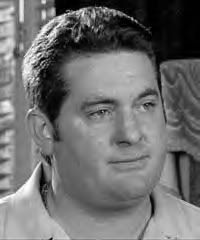
Christopher Penn
LOS ANGELES, California -- Actor Christopher Penn, brother of Sean Penn, was found dead Tuesday, January 24, at a condominium near the beach in Santa Monica, California, according to police reports. He was 43. Police said there were no obvious signs of foul play.
Sean Penn's publicist, Mara Buxbaum, issued a statement saying that "the Penn family would appreciate the media's respect of their privacy during this difficult time."
According to Lt. Frank Fabrega, they discovered the actor's body around 4 p.m. inside the four-story condominium complex after police were called by someone from within the building. An autopsy will be conducted to determine the cause of death, authorities said.

In 'Footloose,' Chris Penn learns to dance to
the tune of 'Let's Hear it for the Boy'
Most people will remember Penn as Willard Hewitt in the 1984 dance classic, "Footloose," opposite Kevin Bacon and Sarah Jessica Parker. He also played baby-faced criminal, Nice Guy Eddie Cabot in director Quentin Tarantino's cult hit, "Reservoir Dogs."
Born in Los Angeles on June 10, 1962, Penn started acting at the age of 12 at the Loft Studio. In 1983, he made his feature film debut in Francis Ford Coppola's youth drama, "Rumble Fish." That same year, he had a small role in the high school football drama, "All the Right Moves" starring Tom Cruise.
Penn was typically cast as a supporting actor or with smaller roles in his movies. In 1985, Penn played a villain in the Clint Eastwood western, "Pale Rider." That same year, he was romantically linked to figure skating champion, Tai Babilonia.
His late father, Leo Penn, directed television shows. His mother, Eileen Ryan, is an actress whose credits include "I Am Sam," "Magnolia" and "Parenthood." Another brother is musician Michael Penn. In 1986, Penn co-starred with his brother, Sean, and mother, Eileen Ryan, in "At Close Range."
Penn's other film credits include "Starsky & Hutch," "Rush Hour" and "To Wong Foo, Thanks for Everything, Julie Newmar."
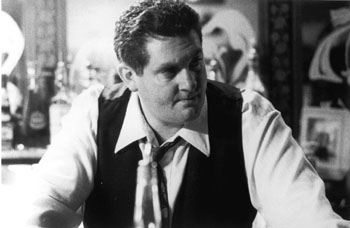
Christopher Penn in 'The Funeral'
In 1996, Penn won the Best Supporting Actor at the Venice Film Festival for "The Funeral." He has two films currently in post-production, "Aftermath" and "King of Sorrow." Penn's latest film, "The Darwin Awards," was scheduled to premiere at the Sundance Film Festival this week.
Penn's television credits include "Entourage," "Everwood" and "Law & Order: Criminal Intent." He played Rudy in the "Fanilow" episode of "Will & Grace." Recently, Penn voiced Officer Eddie Pulaski in the video game "Grand Theft Auto: San Andreas."
Penn is survived by his mother, actress Eileen Ryan, and brothers, actor Sean and musician Michael. Penn was preceded in death by his father, director Leo Penn, who passed away in 1998. |
|
|
|
Post by Monica on Feb 26, 2006 2:50:30 GMT -5
Taken from Morty's posted by h8s_qt 
Emmy-Winning Comedic Actor Don Knotts
by Scott Collins

Don Knotts
LOS ANGELES, California - Don Knotts, the saucer-eyed, scarecrow-thin comic actor best known for his roles as the high-strung small-town deputy Barney Fife on the 1960s CBS series "The Andy Griffith Show" and the leisure-suit-clad landlord Ralph Furley on ABC's '70s sitcom "Three's Company," has died. He was 81.
Knotts, who lived on Los Angeles' Westside, died of lung cancer on Friday, February 24 at UCLA Medical Center, according to Sherwin Bash, his longtime manager. Family members said that Knotts' longtime friend, Andy Griffith was one of his last visitors at the hospital on Friday night.
Despite health problems, Knotts had kept working in recent months. He lent his distinctive, high-pitched voice as Turkey Mayor in Walt Disney's animated family film "Chicken Little," which was released in November. He also did guest spots in 2005 on NBC's "Las Vegas" and Fox's "That '70s Show."
Knotts occasionally co-headlined in live comedy shows with Tim Conway, his sometime co-star in Disney films such as "The Apple Dumpling Gang." Knotts also appeared as the TV repairman in director Gary Ross' whimsical 1998 comedy, "Pleasantville," and voiced the part of T.W. Turtle in the 1997 animated feature, "Cats Don't Dance."
As he grew older, Knotts became a lodestar for younger comic actors. The new generation came to appreciate his highly physical brand of acting that, at its best, was in the tradition of silent-film greats such as Buster Keaton, Stan Laurel and Harold Lloyd.
'Nervous Man' Born
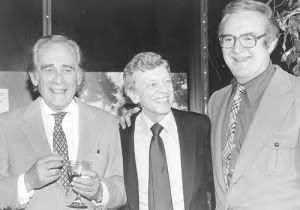
Louis Nye, Don Knotts and Steve Allen on 'The Steve Allen Show'
Knotts first rose to prominence in the late 1950s, joining Louis Nye and other comedy players on "The Steve Allen Show." In 1961, United Artists Records released a comedy album titled "Don Knotts: An Evening with Me," which featured various takeoffs on the "nervous man" routine the comic had made famous on Allen's show.
One of the bits, "The Weatherman," concerned a TV forecaster forced to wing it after the meteorology report fails to make it to the studio by air time.
During the mid- to late 1960s, in a largely unsuccessful bid for major film stardom, Knotts made a series of family films that many connoisseurs now say were critically underappreciated at the time. These include 1964's "The Incredible Mr. Limpet," 1966's "The Ghost and Mr. Chicken" and 1967's "The Reluctant Astronaut." The latter two were made as part of a five-picture deal with Universal Pictures.
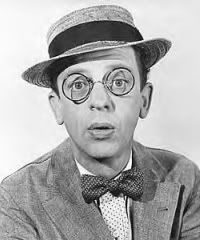
Don Knotts in 'The Incredible Mr. Limpet'
"The Incredible Mr. Limpet," the tale of a meek man who is transformed into a fish, has particularly won recent acclaim. Its early mix of live action and animation was a forerunner of such later films as "Who Framed Roger Rabbit?" and "Space Jam."
At one point, Jim Carrey was said to be considering starring in a 'Limpet' remake, although the project has yet to materialize. Once, when Knotts visited the set of "How the Grinch Stole Christmas," Carrey paid tribute. "I went to him, and I was just like, 'Thank you so much for "The Ghost and Mr. Chicken,"'" Carrey later told an interviewer. "I watched it a hundred times when I was a kid."
Martin Short has likewise hailed Knotts as a major influence, and at least one of Short's recurring characters, shifty-eyed lawyer Nathan Thurm, owes a debt to Knotts' "nervous man" character, created for "The Steve Allen Show" in the 1950s.

Don Knotts in 'Three's Company'
Many TV viewers remember Knotts as Ralph Furley, the ascot-wearing middle-aged landlord who mistakenly viewed himself as a swinger on ABC's hit sex farce "Three's Company." The series starred the late John Ritter as Jack Tripper, a chef who pretended to be gay in order to share an apartment with two attractive young women.
The plot of many episodes hinged on Tripper struggling to keep his secret from an ever-suspicious (and homophobic) Furley. Knotts introduced the character in 1979, during the show's fourth season, when the original landlords, Norman Fell and Audra Lindley, had departed for their own spinoff, "The Ropers."
Immortal Barney Fife[/i][/u][/color][/font][/size] 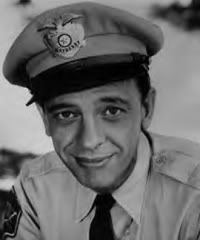 Don Knotts as Barney FifeFor Knotts, who typically worked in Disney comedies and other family-friendly fare, appearing in a sex comedy — then decried by critics as "jiggle TV" — was a major departure. But he stayed with "Three's Company" until it went off the air in 1984 after eight seasons. Don Knotts as Barney FifeFor Knotts, who typically worked in Disney comedies and other family-friendly fare, appearing in a sex comedy — then decried by critics as "jiggle TV" — was a major departure. But he stayed with "Three's Company" until it went off the air in 1984 after eight seasons.
However, it was his portrayal of Barney Fife — a role for which he won five Emmy Awards — that immortalized Knotts to TV viewers. Deputy Fife, an inveterate bumbler, was not in the series pilot, and was at first intended simply to be part of a large ensemble that would surround Griffith, who played Sheriff Andy Taylor in Mayberry, a fictional North Carolina town near Raleigh.
But not long after the series debuted in October 1960, Knotts stole the show. Griffith, who was meant to be the series' comic focus, shifted to playing straight man. The writers began beefing up Fife's role and creating episodes that depended on the sheriff rescuing Fife from his latest predicament. "Andy Griffith" was the most popular comedy on television during its first season, and never dropped from the top 10 for the rest of its eight-year run.
In Knotts' hands, Fife was a fully realized stooge, a hick-town Don Quixote who imagined himself braver, more sophisticated and more competent than he actually was. His utter lack of self-control led him into desperate jams that usually culminated with Fife at the end of his rope, bug-eyed and panting with anxiety. Sheriff Taylor allowed his deputy to have just one bullet, which he kept in his shirt pocket instead of his gun due to past trigger mishaps.
Asked how he developed his most famous character, Knotts replied in a 2000 interview: "Mainly, I thought of Barney as a kid. You can always look into the faces of kids and see what they're thinking, if they're happy or sad. That's what I tried to do with Barney. It's very identifiable."Unhappy Childhood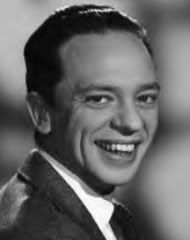 Don KnottsJesse Donald Knotts was born in Morgantown, West Virginia, on July 21, 1924, the youngest of four brothers. His family life was troubled; Knotts' father twice threatened his mother with a knife and later spent time in mental hospitals, while older brother Earl — nicknamed "Shadow" because of his thinness — died of asthma when Knotts was still a teenager. Don KnottsJesse Donald Knotts was born in Morgantown, West Virginia, on July 21, 1924, the youngest of four brothers. His family life was troubled; Knotts' father twice threatened his mother with a knife and later spent time in mental hospitals, while older brother Earl — nicknamed "Shadow" because of his thinness — died of asthma when Knotts was still a teenager.
Years later, the actor did not recall his childhood fondly. "I felt like a loser," he said in a 1976 Los Angeles Times interview. "I was unhappy, I think, most of the time. We were terribly poor and I hated my size." Knotts turned to performing in his early teens, doing an Edgar Bergen-inspired ventriloquism act with a dummy he named Danny.
He enlisted in the Army in 1943 and served in the Pacific, receiving the World War II Victory Medal, among other decorations. After the war, in 1948, he graduated from West Virginia University with an education degree. He soon borrowed $100 and moved to New York to pursue an acting career.
He auditioned for several radio gigs but was turned down. One of his earliest TV roles was on the CBS soap opera, "Search for Tomorrow," where he played Wilbur Peterson — a neurotic young man so troubled he communicated only with his sister — from 1953-55. It was the only non-comedic role he ever played.
But Knotts did not receive widespread attention until he appeared on Broadway in Ira Levin's 1955 comedy, "No Time for Sergeants." Based on Mac Hyman's novel, the play concerned a hillbilly played by a then-unknown Andy Griffith who was drafted into the Air Force. Knotts won plaudits as an overly tense military evaluator.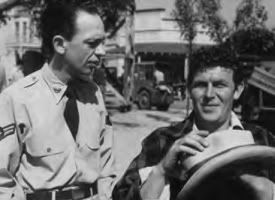 Don Knotts and Andy Griffith in 'No Time for Sergeants'From 1956-60, Knotts further cemented his reputation on NBC's "The Steve Allen Show," where he would play a character named Mr. Morrison, aka "the nervous man." Interviewed on the street, Morrison was asked whether something was making him nervous and would inevitably offer a terse, anxiety-wracked "Nope!" Don Knotts and Andy Griffith in 'No Time for Sergeants'From 1956-60, Knotts further cemented his reputation on NBC's "The Steve Allen Show," where he would play a character named Mr. Morrison, aka "the nervous man." Interviewed on the street, Morrison was asked whether something was making him nervous and would inevitably offer a terse, anxiety-wracked "Nope!"
In the meantime, "No Time for Sergeants" was made into a feature film in 1958, with Griffith and Knotts reprising their roles. The two actors kept in touch, and when Griffith signed to do the TV series as a rural sheriff, Knotts half-jokingly suggested that the lawman would need a deputy.
Knotts left "Andy Griffith" in 1965, later explaining that he believed the producers had always intended for the series to last just five seasons. In a 1967 Times interview, he said, "The grind gets to you in television, and that's primarily the reason I'm concentrating on pictures."
Griffith stayed with the program for three years after Knotts' departure, however, and Knotts agreed to revive his role as Fife in a number of guest spots. Even without Knotts, "Andy Griffith" remained popular, and the show was ranked No. 1 in its final season, 1967-68. Episodes remain syndication favorites and still appear in frequent rotation on cable network TV Land.
But many fans now believe "Andy Griffith" fizzled creatively without Knotts' manic energy — a point that even Griffith himself has conceded. On the TV fan site Jump The Shark, one viewer wrote, "When Barney Fife left town, 'The Andy Griffith Show' changed from a television classic to just another '60s TV show."Staple of Disney Films Don Knotts in 'The Ghost and Mr. Chicken'After 'Griffith,' Knotts stayed busy, although he never quite matched the success he had seen as Barney Fife. An NBC variety hour, "The Don Knotts Show," premiered in 1970 and lasted just one season. The actor subsequently appeared in several live-action Disney features: as a bumbling bandit in 1975's "The Apple Dumpling Gang," a would-be safecracker in 1976's "No Deposit, No Return" and an auto-racing veteran in 1977's "Herbie Goes to Monte Carlo." Don Knotts in 'The Ghost and Mr. Chicken'After 'Griffith,' Knotts stayed busy, although he never quite matched the success he had seen as Barney Fife. An NBC variety hour, "The Don Knotts Show," premiered in 1970 and lasted just one season. The actor subsequently appeared in several live-action Disney features: as a bumbling bandit in 1975's "The Apple Dumpling Gang," a would-be safecracker in 1976's "No Deposit, No Return" and an auto-racing veteran in 1977's "Herbie Goes to Monte Carlo."
Knotts also reprised his role as Fife in "Return to Mayberry," a nostalgic TV movie that delivered enormous ratings for CBS in 1986, and had a recurring role in "Matlock," CBS' courtroom drama starring Griffith. "He saw poignancy in people's pride and pain, and he turned it into something endearing and hilarious," Yarborough said in a statement on Saturday.
In the foreword to Knotts' 2000 memoir, "Barney Fife and Other Characters I Have Known," Griffith wrote that Knotts' personally had little in common with his most famous creation. "Don was not Barney Fife," Griffith wrote. "I know Don to be a bright man and very much in control of himself." Andy Griffith and Don Knotts"As everyone knows, Barney Fife had very little control of himself," Griffith continued. "In the comedy scenes we did, I was often closer to Don than the camera and I could look at him before we started those scenes, and through his eyes, I could see him become Barney Fife." Andy Griffith and Don Knotts"As everyone knows, Barney Fife had very little control of himself," Griffith continued. "In the comedy scenes we did, I was often closer to Don than the camera and I could look at him before we started those scenes, and through his eyes, I could see him become Barney Fife."
A self-described hypochondriac, Knotts suffered numerous health reversals in recent years. He developed vision problems that made driving and some other tasks difficult. In the Fall of 2003, he injured his Achilles tendon while starring in "On Golden Pond" at the New Theatre in Overland Park, Kansas, and had to wear a brace onstage.
Two of Knotts' three marriages ended in divorce. The first, to Kathryn Kay Metz, lasted from 1947 to 1964 and produced two children: Karen, an actress who co-starred with her father in a 1996 stage revival of "You Can't Take It With You," and Thomas, both of whom survive him. From 1974 to 1983, Knotts was married to Loralee Czuchna. He was married to actress Francey Yarborough at the time of his death.[/b] |
|
|
|
Post by Monica on Mar 25, 2006 13:50:33 GMT -5

Ex-Game Show Host Dies in Plane Crash
by Daisy Nguyen

Peter Tomarken
SANTA MONICA, California - Peter Tomarken, a former TV game show host and his wife were killed the morning of Monday, March 13, when their small plane crashed into Santa Monica Bay, authorities said. Rescue crews were searching for a third person also aboard the plane.
The bodies of Tomarken, 63, host of the hit 1980s game show "Press Your Luck," and his wife, Kathleen Abigail Tomarken, 41, were identified by the Los Angeles County coroner's office. "Entertainment Tonight" was the first to report Tomarken's death. "Press Your Luck" was known for contestants shouting the slogan, "Big bucks! No whammies!"
The plane was on its way to San Diego to ferry a medical patient to the UCLA Medical Center, said Doug Griffith, a spokesman for Angel Flight West, a nonprofit organization which provides free air transportation for needy patients. Griffith said the pilot was a volunteer for the group. According to the FAA, the plane was registered to Tomarken and he was the pilot.
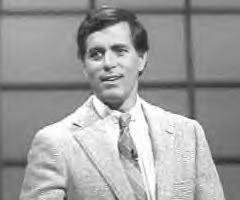
Peter Tomarken on 'Press Your Luck'
The plane apparently had engine trouble and was headed back to Santa Monica Airport, located about two miles inland, but went down about 9:35 a.m. just off shore, said Federal Aviation Administration spokesman Allen Kenitzer.
Rescue boats and divers searching for the third person believed to be aboard the plane were clustered about a half-mile southwest of the Santa Monica Pier where the plane went down in about 19 feet of water. Luis Garr said he didn't hear the engine but heard the splash as the plane "kind of landed into the water."
"It's a big splash, a huge splash. . . . Then it started going down," Garr said. "The wings were still floating so I was, 'Get out! Get out!' because the door was still available to get out and nobody came out. So the plane kept going down, down, down."
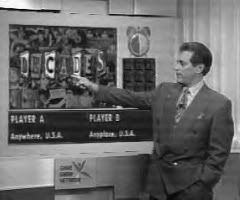
Peter Tomarken on 'Decades'
Tomarken was born on December 7, 1942 in Olean, New York. Tomarken's agent, Fred Wostbrock, said his client's first game show was 1983's "Hit Man!," which ran 13 weeks on NBC, followed by the four-year hit, "Press Your Luck" on CBS. Next, he was at the helm of 1987's "Bargain Hunters."
Soon, Tomarken took over the hosting duties of 1988's "Wipe-Out," 1994's "Decades" and 2000's "Paranoia." Wostbrock said, "He was always a fun guy to be around, and he just loved the genre of game shows." |
|
|
|
Post by Monica on Mar 25, 2006 13:51:39 GMT -5

'Reds' Actress Maureen Stapleton 1925-2006
by Dennis McLellan

Maureen Stapleton in 'Private Sessions'
LENOX, Massachusetts - Maureen Stapleton, the acclaimed stage, screen and television character actress who won an Academy Award for her supporting role in the 1981 film "Reds," died Monday, March 13. She was 80. Stapleton, a longtime smoker, died of complications from respiratory ailments at her home in Lenox, Massachusetts, said her daughter, Katharine Allentuck Bambery. She had been ill for about two years.
Stapleton once noted that her friend Marilyn Monroe, a fellow Actor's Studio member whose talent she admired, was not taken seriously as an actress because of her beauty. "I never had that problem," Stapleton said. "People looked at me on stage and said, 'Jesus, that broad better be able to act.'"
During her more than 50-year career, Stapleton was known as an outstanding character actress who excelled in dramatic and comedic roles. At the heart of her acting was what one critic referred to as her "remorseless honesty."

Maureen Stapleton in 'The Rose Tattoo'
Stapleton's breakthrough role came in 1951, when she played the grieving, love-struck Sicilian American widow, Serafina delle Rose, in the original Broadway production of Tennessee Williams' "The Rose Tattoo." The role earned Stapleton her first Tony Award. She went on to play leading roles in Williams' "27 Wagons Full of Cotton" in 1955 and "Orpheus Descending" in 1956.
"On stage, you couldn't take your eyes off her," actor-comedian Dom DeLuise, a longtime friend, told The Times on Monday. "She was a grand actress, and she had something that made it all seem like she was making it up."
Among Stapleton's many Broadway credits are Lillian Hellman's "Toys in the Attic," and "Plaza Suite" by Neil Simon. "I just loved her," Simon told The Times on Monday. "She was just a wonderful person to work with and personally she had the most marvelous sense of humor. She was so unique — not many actresses are like her."

Maureen Stapleton and George C. Scott in 'Plaza Suite'
"There was always a play that I wrote that I could have used her, still today," Simon recalled. "I remember doing 'Plaza Suite' with George C. Scott, who's a great actor and sometimes difficult to deal with. But she knew how to calm him down, and it was always wonderful to watch her do that. But she was just a brilliant actress."
Stapleton won her second Tony Award for "The Gingerbread Lady" in 1971. Her extensive theatre credits include "The Barretts of Wimpole Street," "The Secret Affairs of Mildred Wild," "The Little Foxes," "The Club Champion's Widow," "Juno and the Paycock," "The Country Girl" and "The Glass Menagerie."
Stapleton stage work continued with roles in "The Cold Wind and The Warm," "The Seagull," "Richard 111," "The Crucible," "The Emperor's Clothes," "The Bird Cage," "Detective Story," "Antony and Cleopatra" and "Norman, Is That You?"

Maureen Stapleton in 'Lonelyhearts'
Stapleton was nominated for an Oscar for best supporting actress in her first film role — as a frustrated wife who seduces a cub reporter played by Montgomery Clift in "Lonelyhearts," the 1958 film version of Nathanael West's novel. She also received Oscar nominations for her performances in "Airport" (1970) and Woody's Allen's "Interiors" (1978).
In Warren Beatty's epic "Reds," she portrayed anarchist/writer Emma Goldman. Asked backstage by a reporter whether she had expected to win the Oscar, the always-candid Stapleton replied: "Yes, because I'm old and tired and I lost three times before."
Among her other film credits are "The Fugitive Kind" and "Bye Bye Birdie" starring as Dick Van Dyke's over-protective mother. Taking her stage role to film, Stapleton acted opposite Walter Matthau in "Plaza Suite." She also had major roles in "The Fan," "Cocoon," "The Money Pit," "Nuts" and "The Last Good Time."

Charles Durning and Maureen Stapleton take to the dance floor in
the television movie, 'Queen of the Stardust Ballroom'
Stapleton, who appeared frequently in television dramatic showcases such as "Studio One," "Kraft Playhouse" and "Playhouse 90" in the 1950s, won an Emmy for her leading role in "Among the Paths to Eden" in 1967.
She was nominated for an Emmy in the title role of "Queen of the Stardust Ballroom." In the 1975 TV-movie, she played a lonely widow who finds romance in a local dance hall with a letter carrier played by Charles Durning.
"There are many roads to good acting," Stapleton said in "A Hell of a Life," her 1995 autobiography. "I've been asked repeatedly what the 'key' to acting is, and as far as I'm concerned, the main thing is to keep the audience awake."

Meryl Streep and Maureen Stapleton in 'Heartburn'
One of two children, Stapleton was born June 21, 1925, in Troy, New York, to a working class family of Irish descent. During her early years, she endured fights between her mother and her alcoholic father, who deserted the family when Stapleton was 5. Stapleton found frequent escape at the movies, which fueled her ambition to become an actress.
"Looking back," Stapleton wrote in her tell-all autobiography, "I don't feel I had a choice. For a fat, struggling kid like me, the only way out was to be someone else — an actor."
In a 1987 interview with the Toronto Star, Stapleton said her desire to act had nothing to do with "lofty ideas about artistic urges." Instead, it was those Hollywood movies starring Jean Harlow, Clark Gable and other glamorous stars, in which "everybody was beautiful, rich and happy."

Maureen Stapleton in 'The Electric Grandmother'
"I thought if you got to be an actress you automatically ended up looking like that, thin and beautiful," she recalled in a 1965 New York Times interview.
After graduating from high school, Stapleton arrived in Manhattan in 1943 with $100 in savings from odd jobs and a determination to become an actress. She supported herself by posing nude for artists, keeping books at a hotel and doing other odd jobs while spending her evenings studying acting with Herbert Berghof.
She made her Broadway debut in 1946, with a walk-on part as a village girl in a revival of J.M. Synge's "The Playboy of the Western World." She graduated to better roles and joined the prestigious Actors Studio, whose members included Marilyn Monroe and Marlon Brando, who used to crash in her one-room apartment.

Maureen Stapleton
Offstage, Stapleton has been described as being feisty, boisterous, prone to cursing and having a bellowing laugh. The first time she met Burt Lancaster at a party in the 1950s, she asked him why he was wearing sunglasses indoors. When he didn't answer, she took a swing at him and missed.
For many years, alcohol played a role in her behavior. In her autobiography, Stapleton was frank about her strengths and weaknesses, which included heavy drinking (though never while performing) and a string of phobias, including fears of flying, elevators and heights.
Stapleton had two failed marriages. Her first husband was theatrical manager and producer Max Allentuck. Her second marriage was to screenwriter David Rayfiel. She also had a long affair with Broadway legend George Abbott that began when she was 43 and he was 81 and ended 10 years later with the director "stepping out" on her with another, younger woman.
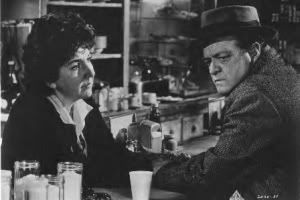
Maureen Stapleton and Van Heflin in 'Airport'
But Stapleton always maintained a self-deprecating sense of humor. For her Oscar-nominated role in "Airport," she wore a favorite old dress that she had bought during her slimmer days. "I actually think my girdle should have won for technical achievement," she wrote in her book.
"She was full of fun," DeLuise said. "When she came to your house, she sat down, you ate, you laughed — you just didn't want to go anywhere because she was there. You wanted the time to last forever."
In the mid 1980s, Stapleton moved to Lenox to be closer to her daughter and her grandchildren. She had been semi-retired for the last 10 years. In addition to her daughter, she is survived by a son, Daniel Allentuck; two grandchildren; and a brother, John Stapleton. |
|
|
|
Post by Monica on Mar 25, 2006 13:52:27 GMT -5

Celebrity Designer Oleg Cassini
by Barbara Thomas
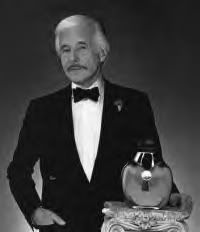
Oleg Cassini
Oleg Cassini, the son of Russian aristocrats who became a savvy influence in the world of fashion and helped define the style of Jacqueline Kennedy, died on Friday, March 17. He was 92. Cassini's wife, Marianne, said the designer suffered a broken blood vessel in his head and died in a Long Island hospital.
As famous for his colorful lifestyle as he was for his clothes, Cassini was married to Hollywood star Gene Tierney and engaged to Grace Kelly — before she became a princess. As "secretary of style" to the most stylish first lady, Jacqueline Kennedy, Cassini foreshadowed a time when designers would be defined by their celebrity clients.
As a businessman, Cassini was an innovative leader in the fashion industry. He was the first to understand the power of franchising his name, with as many as 50 licenses, including sunglasses, watches and children's clothes. (At one time, Cassini estimated an annual worldwide retail volume of $400 million.)

Director Alfred Hitchcock, Actress Grace Kelly and Designer Oleg
Cassini at the 1954 'Rear Window' movie premiere
He bucked fashion tradition by refusing to show with other designers during the New York seasons, instead taking his designs directly to the public, exhibiting his collections in stores across the country and becoming a regular television guest on "The Tonight Show" and "The Mike Douglas Show."
He understood there was wealth to be had in ready-to-wear instead of high fashion. He was the first to introduce brightly colored shirts for men and was responsible for the short-lived trend of the Nehru jacket. He popularized the pillbox hat as an accommodation to Kennedy's newly acquired bouffant hairdo.
In spite of all this, he struggled for many years to prove he was not just a playboy dilettante but indeed a serious fashion player. Ironically, by dressing the first lady, the immigrant galvanized an American fashion sensibility. As the world took its cues from European designers, Cassini offered an elegant new way to be classically American.

Oleg Cassini
Cassini took conservative staples, such as the shirt dress, the simple shift and the wool coat, and made them into new American classics. And he made them sexy. The woman wore the clothes, the clothes did not wear the woman.
But Cassini's reputation as bon vivant and man about town overshadowed his credibility as a serious designer. This was unfortunate, because he never got much credit among the fashion industry, said Edie Locke, president of the Los Angeles branch of the Fashion Assn.
"One thought 'celebrity' before taking him very seriously as a designer, which probably was not justified. It wasn't the way that you think of a Calvin [Klein] or a Donna [Karan]," said Locke, who was editor in chief of Mademoiselle magazine through the 1970s.

Oleg Cassini
Cassini seemed destined to lead a fast life, from his beginnings as the son of the Countess Marguerite Cassini, daughter of a Russian ambassador to the United States, and Alexander Loiewski, a Russian diplomat. In 1917 when the Czarist government was overthrown, the family fled, first to Denmark and then to Florence, Italy, where they settled and Marguerite opened a dress shop.
Cassini studied art and opened a tiny salon, getting orders from the European aristocracy and American debutantes, whom he did his best to introduce to the ways of romance, as he tactfully noted in his 1987 autobiography, "In My Own Fashion."
He came to New York in 1936 and was soon joined by his brother Igor, who went on to fashion a career as the Hearst newspaper gossip columnist Cholly Knickerbocker. The brothers found joblessness and near poverty but, armed with good tuxedos and European manners, they eventually made their way into East Coast society.

Oleg Cassini and Grace Kelly
Cassini was briefly and disastrously married to cough syrup heiress Merry Fahrney, becoming the fourth of her nine ex-husbands. After the divorce and scandalous routing by gossip columnists ("the naughty count" and "international itinerant"), Cassini moved to Hollywood in 1940, where he worked at first in the costume department of Paramount Studios and later Twentieth Century Fox.
He designed costumes for Veronica Lake, Marilyn Monroe and Gene Tierney, whom he married in 1941. The couple enjoyed life in Hollywood circles. He gave up his title as a count to become a U.S. citizen and enlisted in the U.S. Army during World War II, serving stateside.
But the Hollywood high life would end with the birth of the Cassinis' first child, Daria. When Tierney was pregnant, she was exposed to rubella by an overzealous fan. Daria was born blind and severely retarded, a devastating blow to the couple. Cassini later wrote that he had fantasies about killing himself and his daughter.

Oleg Cassini (far right) with his ex-girlfriend Rita
Hayworth (left) and Cassini's first wife, actress Gene
Tierney at a Hollywood social event
Tierney plummeted into a deep depression, which she battled for the rest of her life. She divorced Cassini in 1947, but they reconciled and had a second daughter, Christina. The couple divorced a second time in 1952. Still, even after she remarried, they remained friends until the actress' death from emphysema in 1991.
Cassini's name was linked to a number of beautiful women including Anita Ekberg, Linda Evans, Jill St. John and dozens of models. Perhaps the most famous name of all was actress Grace Kelly, to whom he was unofficially engaged for two years. Her family opposed the courtship because he was divorced.
Kelly unceremoniously announced to Cassini that their relationship was over because she was going to marry Prince Rainier of Monaco. In spite of the heady social life, Cassini was determined to become a successful fashion designer. Ignoring Tierney's protests, he returned to New York in 1950 to open his own fashion house.
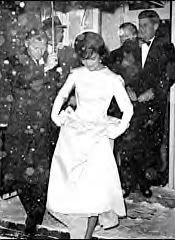
In a gown designed by Oleg Cassini,
First Lady Jacqueline Kennedy with her
husband, President John F. Kennedy,
on their way to his 1961 inaugural.
It wasn't until a newly elected John F. Kennedy asked him to be the official designer for his wife that he achieved his greatest success. Kennedy's father, Joseph, picked up the tab for the nearly 300 outfits designed for the first lady in her 1,000 days of office. A series of letters between the designer and first lady were chronicled in his 1995 book "Oleg Cassini: A Thousand Days of Magic."
Cassini's days as a movie costume designer proved valuable as he and the first lady agreed she should dress for the role and not for herself. The letters show the details both of them paid attention to: She should wear a cloth coat to the inauguration so as not to look as matronly as previous first ladies. She should show cleavage, but not too much.
Years later, fashion runways still pay homage to the simple coats, A-line dresses and pillbox hats favored by Jacqueline Kennedy. After President Kennedy's assassination, Cassini and the first lady parted ways, but the designer's name was imprinted in the American consciousness. He had, by then, also become a full-fledged member of what brother Igor had named "the jet set."

Oleg Cassini at a book signing of his autobiography in 2005
Cassini continued to live and love well, but like many aging playboys, he saw the errors of his ways, not in romancing, but in promoting the use of fur. He blamed himself for the death of 250,000 leopards that were killed as women flocked to copy a coat he had designed for Mrs. Kennedy. "After that I said, 'I will do my best to redeem myself,'" he told The Times.
"St. Francis of Assisi has always been an inspiration to me," Cassini had said. "He was a playboy, too." Cassini became an animal activist, earning wide praise from animal rights groups. His last great project was introducing micro-fiber fake furs in 1999. Cassini lived in Gramercy Park in New York City with a menagerie of animals.
Cassini is survived by his wife, Marianne; two daughters by ex-wife, actress Gene Tierney, Antoinette Daria Cassini and Christine Cassini. He also leaves behind several grandchildren. He was preceded in death by his brother, Gossip Columnist Igor, who died in 2002; first wife, Merry Fahrney, who died in 1940 and second wife, Tierney, who passed away in 1991. |
|
|
|
Post by Monica on Mar 25, 2006 13:53:16 GMT -5

'Hee Haw' Co-Host Buck Owens
by Greg Risling

Buck Owens
LOS ANGELES, California - Singer Buck Owens, the flashy rhinestone cowboy who shaped the sound of country music with hits like "Act Naturally" and brought the genre to TV on the long-running "Hee Haw," died on Saturday, March 25. He was 76.
Owens died at his home, said family spokesman Jim Shaw. The cause of death was not immediately known. Owens had undergone throat cancer surgery in 1993 and was hospitalized with pneumonia in 1997.
His career was one of the most phenomenal in country music, with a string of more than 20 No. 1 records, most released from the mid-1960s to the mid-1970s. They were recorded with a honky-tonk twang that came to be known throughout California as the "Bakersfield Sound," named for the town 100 miles north of Los Angeles that Owens called home.

Buck Owens
"I think the reason he was so well known and respected by a younger generation of country musicians was because he was an innovator and rebel," said Shaw, who played keyboards in Owens' band, the Buckaroos. "He did it out of the Nashville establishment. He had a raw edge."
Owens was modest when describing his aspirations. "I'd like to be remembered as a guy that came along and did his music, did his best and showed up on time, clean and ready to do the job, wrote a few songs and had a hell of a time," he said in 1992.
An indefatigable performer, Owens played a red, white and blue guitar with fireball fervor. He and the Buckaroos wore flashy rhinestone suits in an era when flash was as important to country music as fiddles. Among his biggest hits were "Together Again," also recorded by Emmylous Harris, "I've Got a Tiger by the Tail," "Love's Gonna Live Here," "My Heart Skips a Beat" and "Waitin' in Your Welfare Line."
And he was the answer to this music trivia question: What country star had a hit record that was later done by the Beatles? "Those guys were phenomenal," Owens once said. Ringo Starr recorded "Act Naturally" twice, singing lead on the Beatles' 1965 version and recording it as a duet with Owens in 1989.
In addition to music, Owens had a highly visible TV career as co-host of "Hee Haw" from 1969 to 1986. With guitarist Roy Clark, he led viewers through a potpourri of country music and hayseed humor. "It's an honest show," Owens told The Associated Press in 1995. "There's no social message — no crusade. It's fun and simple."
Owens himself could be rebellious, choosing among other things to label what he did "American music" rather than country. "I took a little heat," he once said. "People asked me, 'Isn't country music good enough for you?'" He also criticized the syrupy arrangements of some country singers, saying "assembly-line, robot music turns me off."
After his string of hits, Owens stayed away from the recording scene for a decade, returning in 1988 to record another No. 1 record, "Streets of Bakersfield," with Dwight Yoakam. He spent much of his time away concentrating on his business interests, which included a Bakersfield TV station and radio stations in Bakersfield and Phoenix.
"I never wanted to hang around like the punch-drunk fighter," he told The Associated Press in 1992. He had moved to Bakersfield in 1951, hoping to find work in the thriving juke joints of what in the years before suburban sprawl was a truck-stop town on Highway 99, between Los Angeles and the San Francisco Bay area.
"We played rhumbas and tangos and sambas, and we played Bob Wills music, lots of Bob Wills music," he said, referring to the bandleader who was the king of Western swing. "And lots of rock 'n' roll," he added. Owens started recording in the mid-1950s, but gained little success until 1963 with "Act Naturally," his first No. 1 single.
Alvis Edgar Owens Jr. was born in 1929 outside Sherman, Texas, the son of a sharecropper. With opportunities scarce during the Depression, the family moved to Arizona when he was 8.
He dropped out of school at age 13 to haul produce and harvest crops, and by 16 he was playing music in taverns. He once told an audience, "When I was a little bitty kid, I used to dream about playing the guitar and singing like some of those great people that we had the old, thick records of."
Owens' first wife, Bonnie Owens, sometimes performed with him and went on to become a leading backup singer after their divorce in 1955. She had occasional solo hits in the '60s, as well as successful duets with her second husband, Merle Haggard.
One of her two sons with Owens also became a singer, using the name Buddy Alan. He had a Top 10 hit in 1968, "Let the World Keep on a-Turnin'," and recorded a number of duets with his father. In addition to Buddy, he is survived by two other sons, Michael and John. |
|
|
|
Post by Monica on Apr 3, 2006 7:31:08 GMT -5

'General Hospital' Producer Gloria Monty 1921-2006
by Valerie J. Nelson

(L-R) Sisters Norma and Gloria Monty
RANCHO MIRAGE, California - Gloria Monty, a producer whose reinvention of the ABC daytime drama "General Hospital" in the late 1970s turned it into a pop phenomenon that helped modernize television soap operas, has died. She was 84.
Monty died of cancer on Thursday, March 30 at her home in Rancho Mirage, California according to an announcement made by ABC. Monty was the model for the motherly soap opera producer in the award-winning 1982 film, "Tootsie," starring Dustin Hoffman and Jessica Lange.
When she took the reigns of "General Hospital" in 1978, the show hovered on the brink of cancellation, and Monty was given 13 weeks to save it. With more women joining the work force, the traditional audience for soap operas was eroding, and Monty needed to hook the teenage and college crowd.
She broke new ground in storytelling by introducing action-adventure and science fiction to the tried-and-true daytime staples of romance and infidelity. She cast younger actors, quickened the pacing, upped the glamour and brought in a Broadway designer to modernize the set.
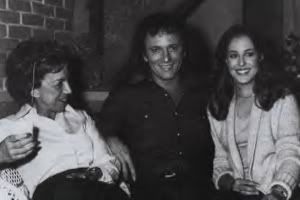
Gloria Monty with Anthony Geary and Genie Francis
One of her boldest moves was a shocking and oddly disconcerting story line: After the troubled Luke raped Laura, the sweetheart of the show, the pair began a romance. Outraged rape victims and counselors accused Monty of glorifying violence against women.
Monty recast the controversial plot turn in a 1987 Us Weekly interview. "Some people call it a rape. We call it a seduction," she said. When Luke and Laura, portrayed by Anthony Geary and Genie Francis, respectively, got married, it was considered the television event of 1981.
Elizabeth Taylor, a fan, was cast as a wedding guest. Newsweek put the bride and groom on the cover along with the headline, "TV's Hottest Show." An estimated 30 million viewers tuned in, a record for a daytime drama. Geary had almost finished his 13-week stint in 1978 as a character's ne'er-do-well brother when Monty came to him and said, "I have an idea for this character."
"I told her, 'I don't really like soaps.' She said to me, 'Honey, neither do I. We're going to change all that,'" Geary told the Atlanta Journal-Constitution in 2003. "Gloria gave us the kind of freedom that no longer exists in the genre," Geary recalled. "It was a time when decisions were not made by committee."

Gloria Monty directing a scene for 'General Hospital'
With Monty at the helm, the show won two Emmy Awards as outstanding daytime drama series. By the 1979-80 season, "General Hospital" had moved to the top of the ratings and stayed at No. 1 for five years. Nearly three-quarters of its audience was said to be made up of 18- to 34-year-olds prized by advertisers.
"During Gloria's early reign, I had the great good fortune to watch her genius at work. She was tough and fearless and brilliant," Jill Farren Phelps, the show's executive producer, said in a statement.
At the height of "General Hospital" mania, the show earned upwards of $50 million a year — about one-fourth of ABC-TV's annual profits. Monty, who did not publicly disclose her salary, reportedly made more than $2 million a year.
Saying "nine years was more than enough," Monty took a respite from the show in 1987 to develop prime-time series and films for television. One short-lived 1983 series, "The Hamptons," featured characters who were all rich and miserable.
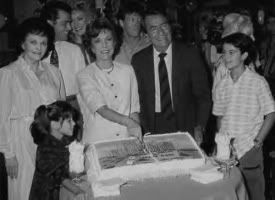
Gloria Monty cuts the cake with the cast of 'General Hospital'
as they celebrate a landmark anniversary together on the set
Monty returned to "General Hospital" in 1990 to try to restore the slumping soap to its No. 1 spot, which had been assumed by CBS' "The Young and the Restless." The 5-foot, 2-inch producer was known for being authoritative, but the second time around her ideas to revive "General Hospital" seemed out of step with the fictional world of Port Charles.
She phased out longtime characters, such as the moneyed Quartermaine family and introduced new working-class characters to give the show an "Upstairs, Downstairs" flavor. "GH," as aficionados call it, had become "one long non-sequitur," the Chicago Tribune said in 1993. When Monty left the series in 1992, ABC cited "personal reasons" as the cause of her departure.
She was born Gloria Montemuro on August 12, 1921, in New Jersey to Joseph, a builder, and his wife, Concetta. Soon after earning her master's degree in drama from Columbia University, Monty married Robert O'Byrne, a theater producer and writer.
At improvisational workshops in New York, she worked with Bea Arthur, Marlon Brando and Walter Matthau. With her husband, she also directed summer stock for five years at their theater and workshop on Long Island.
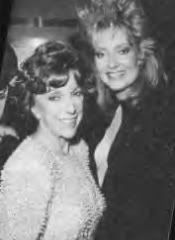
Gloria Monty and Sharon Wyatt at the
1987 Soap Opera Digest Awards
In 1954, CBS hired her to direct the pilot for the daytime drama "Secret Storm," which she produced and directed for 14 years. She produced another soap, "Bright Promise," before joining ABC in 1972 to produce entertainment specials.
When Monty hired a woman as her assistant director on "Secret Storm," she was told it wouldn't work. She was asked: How were those wearing earphones supposed to distinguish between two female voices? Monty agreed that was a problem until she stopped to think and said, "Nobody has any trouble telling the difference between two male voices."
O'Byrne, Monty's husband of 39 years, died in 1991. Monty is survived by her sister, Norma, who was a head writer on "General Hospital." |
|
Jake
Viewer  Jesse
Jesse
Posts: 29
|
Post by Jake on Apr 4, 2006 9:07:39 GMT -5
wow i can't believe she's gone.
|
|



